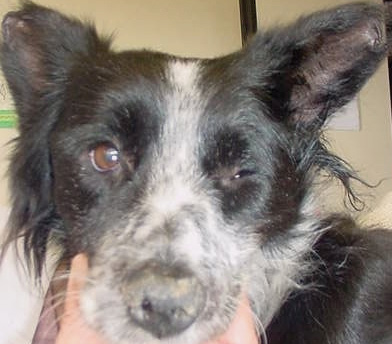Canine Infectious Diseases: Self-Assessment Color Review, Q&A 17
| This question was provided by CRC Press. See more case-based flashcards |

|
Student tip: This case is a well-illustrated clinical history. |
A 4 year old intact male mixed-breed dog was evaluated because of a 4-day history of left-sided head tilt and uncoordinated gait that had become progressively worse over that time. The dog lived in Messina, Italy. He was regularly vaccinated with core vaccines and received prophylaxis for endoparasites and ectoparasites. On physical examination, abnormal findings included a left-sided head tilt, circling and falling, Horner’s syndrome, facial nerve paralysis (see image), and positional strabismus on the left side. Neurologic examination revealed no abnormalities in mentation, placing reaction abnormalities, limb paresis/paralysis, or involvement of other cranial nerves.
| Question | Answer | Article | |
| What differential diagnoses should be considered? | Head tilt, circling and falling, and positional strabismus are suggestive of left-sided peripheral vestibular disease. Horner’s syndrome and facial nerve paralysis suggest involvement of the middle and inner ear. Post-ganglionic sympathetic fibres are responsible for the autonomic innervation of the eye and these, along with cranial nerve VII, pass near the petrous temporal bone and tympanic bulla. A central vestibular disorder was less likely because neurologic examination revealed no abnormalities in mentation, placing reaction abnormalities, limb paresis/paralysis, or involvement of other cranial nerves. Based on the acute onset, the progressive nature of the clinical signs, and the dog’s age, inflammatory/infectious causes seemed most likely, although neoplasia should also be considered.
|
Link to Article | |
| What is your initial diagnostic plan? | Initial investigations should include otoscopic examination of both ears to evaluate for otitis media, and imaging of the ear under general anaesthesia. Otoscopy or video-otoscopy should be performed under deep sedation or general anaesthesia and should involve thorough examination of the external ear canal and tympanic membrane (to assess for a ruptured, opaque, or bulging tympanic membrane). Open-mouth anterior–posterior radiographs of the skull can detect severe abnormalities of the bullae (such as lysis, thickening, and presence of fluid or tissue inside the bulla). However, CT is more sensitive for detection of otitis media and should be recommended in this case following otoscopy, should the owner’s finances allow.
|
Link to Article | |
To purchase the full text with your 20% discount, go to the CRC Press Veterinary website and use code VET18.
